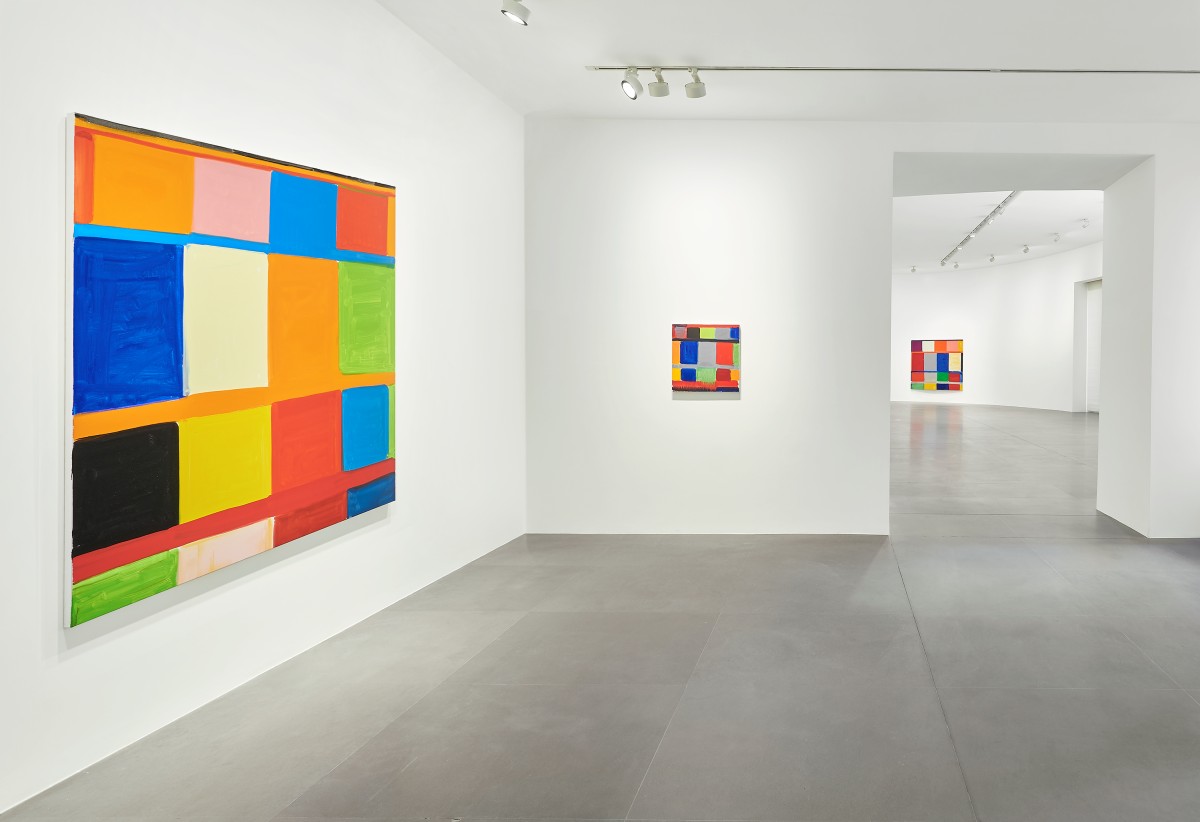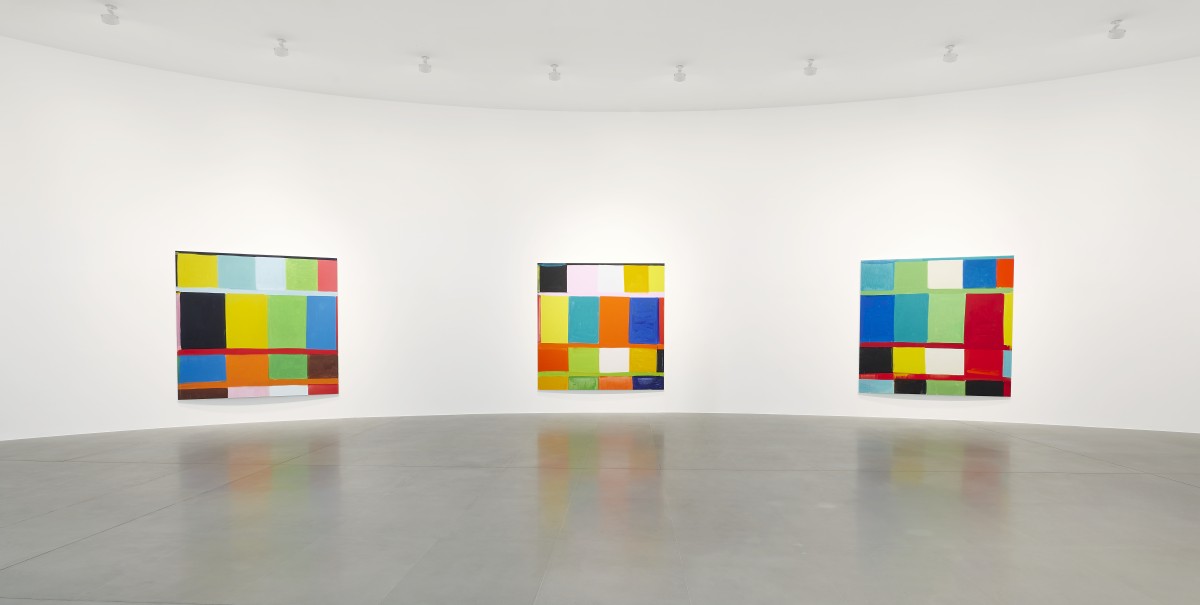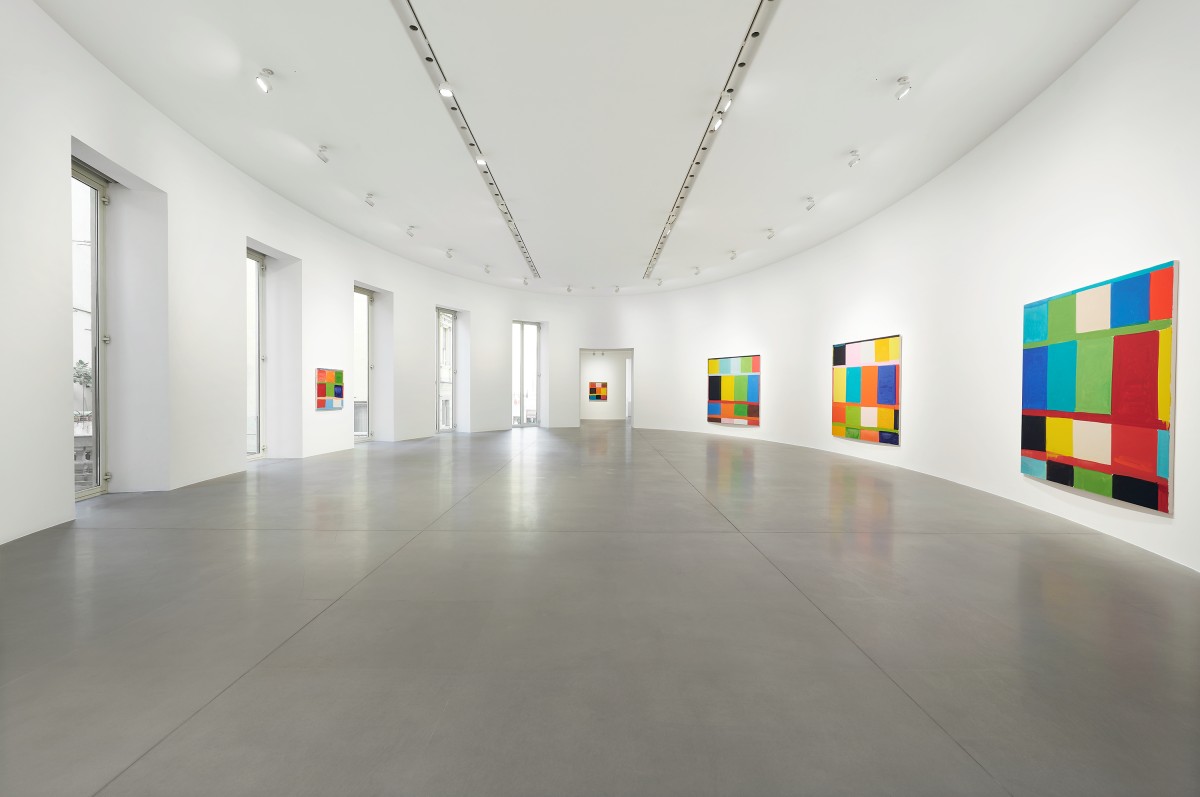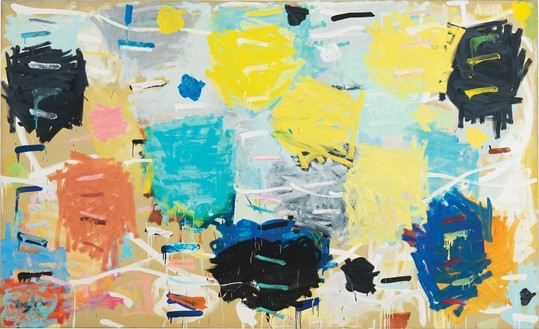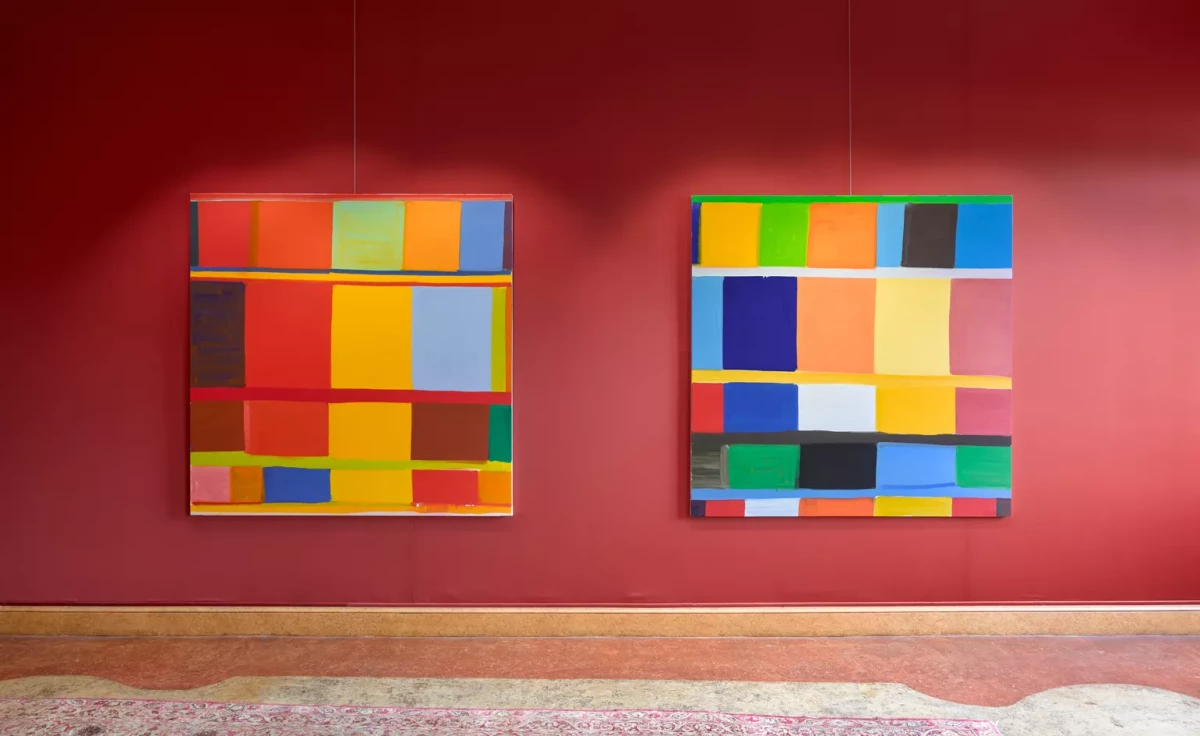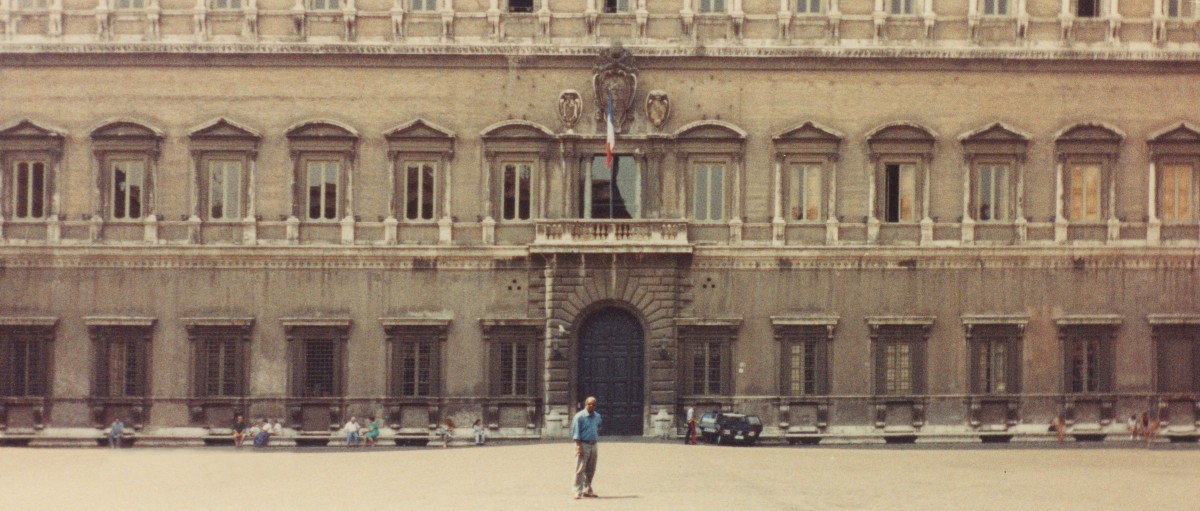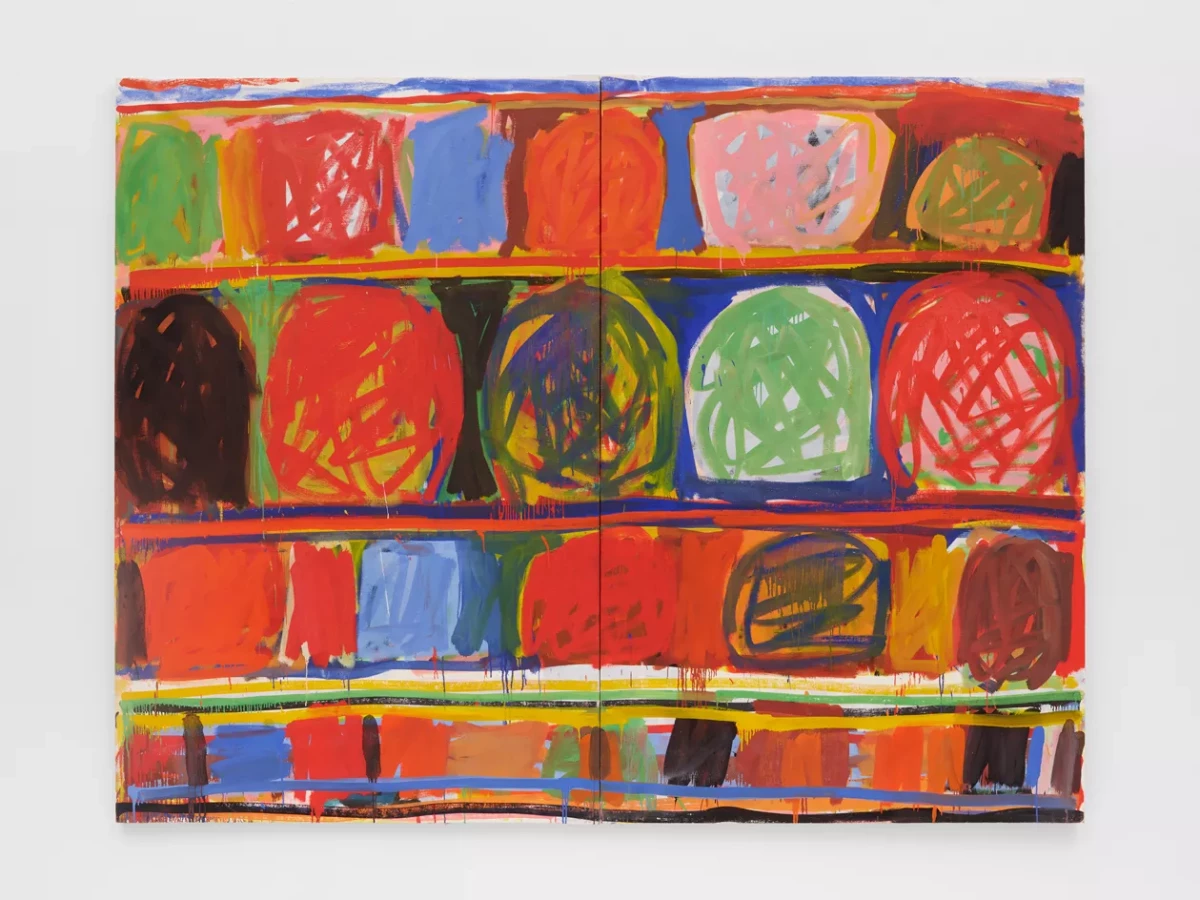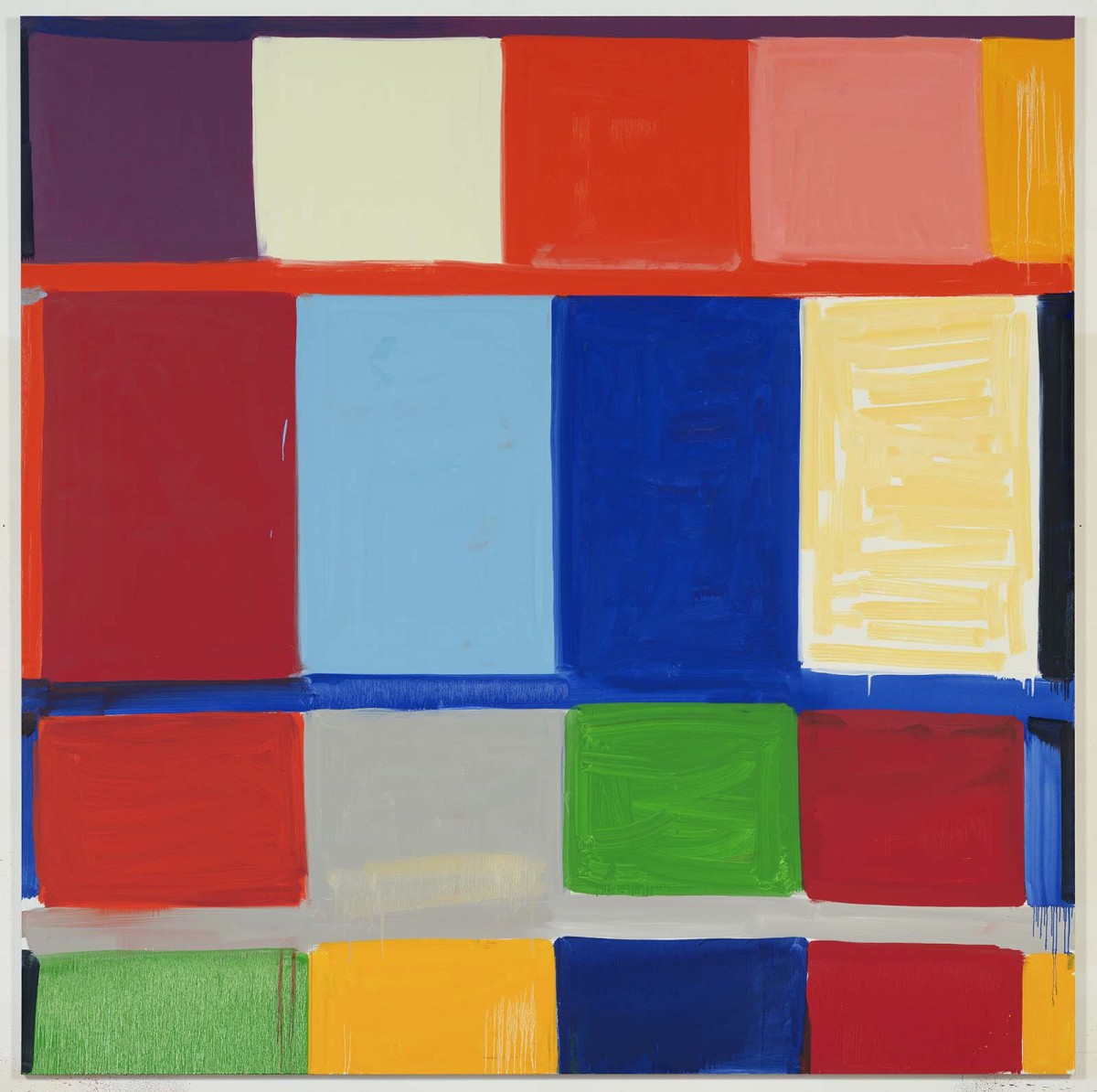Stanley Whitney
Published: , Interview with Stanley Whitney for the book "New Waves. Contemporary Art and the Issues Shaping Its Tomorrow", 2021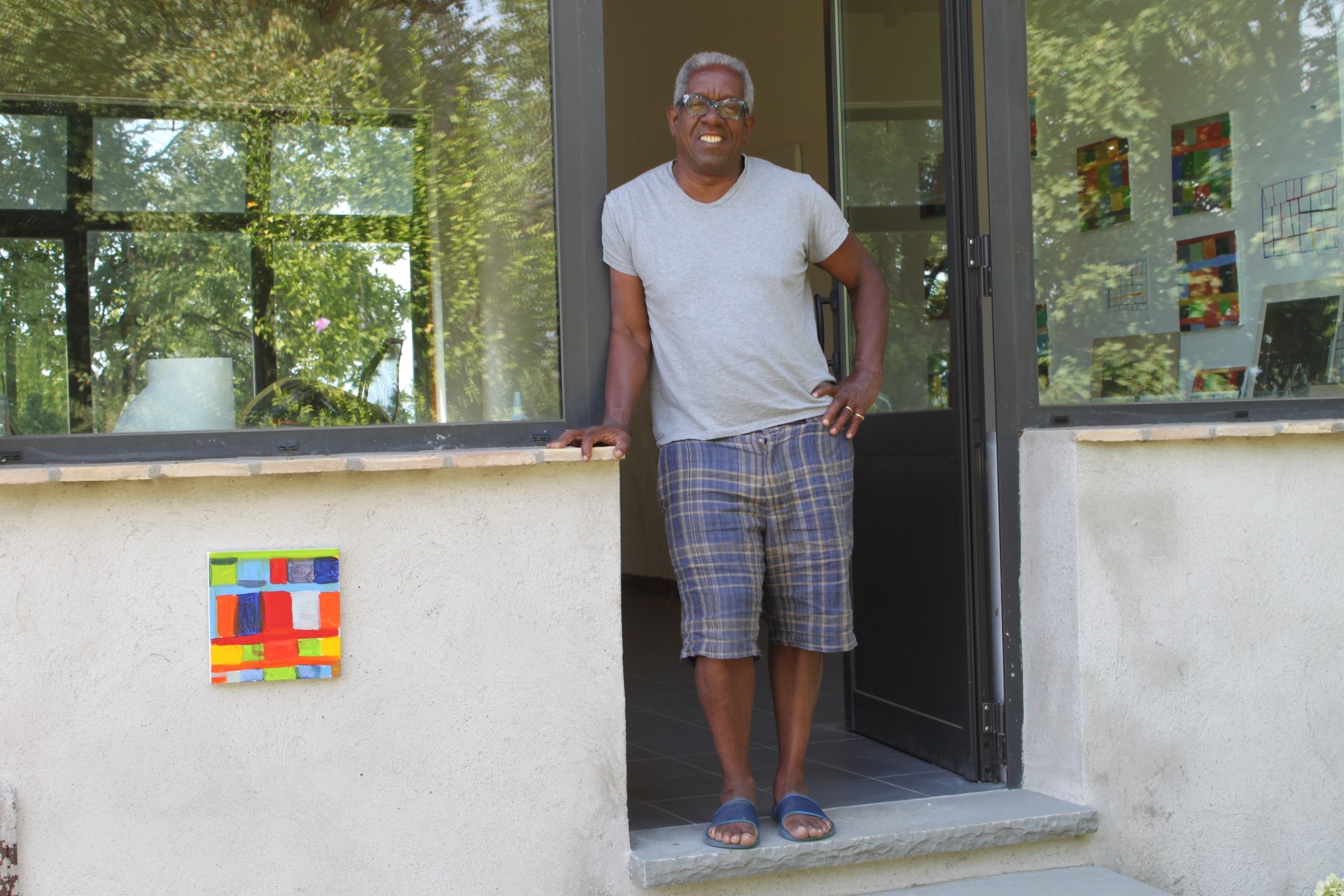
Marta Gnyp: How was the lockdown time for you?
Stanley Whitney: It wasn’t bad for me. Being an artist, you’re used to being by yourself anyway. All of a sudden I couldn’t get to the studio, sat at home, read a lot, did some drawings and just had time out – not too much business, which was kind of good.
MG: Do you normally work with assistants?
SW: I work on my own. I have just one studio manager who does all my administrative work.
MG: Didn’t you miss working in the studio?
SW: My studio is outside where I live. I have a car and I could have gone there, but it was a time to reflect and think about things that had been going so fast. So much traveling, shows and art fairs, all that had to stop. You kind of felt that it was going too fast. I was downtown Manhattan the other day; everyone had fled the city so it got quiet again; you could hear the birds. It was kind of nice.
MG: Many of us have been rethinking the situation but I wonder whether after the lockdown and corona period anything really changes, especially in the art world. For example, now we have switched into viewing art online. I can’t imagine that this will replace the viewing works in flesh.
SW: I agree. I think people do miss going to the galleries and seeing the real art. I don’t think online will last that long, but maybe crowds will get smaller and traveling will be less for most of the people. I don’t know how the art fairs will come back, but I think that serious collectors and serious art people will be there. We’ll see how it rebuilds, but I think it will rebuild.
MG: Do you think that people miss a lot looking at your work online?
SW: Definitely. I think of my work more about living with it than seeing it, so, yeah, people miss a lot. If an artist is established, people know the work and how to deal with it, but if you don’t know the work it’s complicated.
MG: Do you think viewing art online can affect the artistic production in general?
SW: I guess, it might reflect somehow in what some artists will make. It’s got to be in this online thing. As a painter, you want that intimate conversation of viewing it. My work looks okay online, with the computer light and all that, but you do miss the scale and the hands. One of the reasons I paint in oil is that I have that hand where you feel the touch.
MG: Let’s us go to the other very urgent subject, especially in the US, protests, demonstrations, and riots related to the BLM. You’ve been through similar protests in the past as well. A lot of artists now feel the urge to be political and to make political art. Do you think that art should be political?
SW: Well, you can say all art is political. The question is whether it’s illustration of politics. There are all kinds of art; there are so many different kinds of artists, even for young artists there are so many choices of what kind of artist they could be. I think some people will try to get advantage of the political situation; some people’s work embraces that kind of images. My work has been very political anyway – just who I am, what I do, what it reflects. Sometimes I think about Picasso painting Guernica and then Matisse making beautiful paintings in Nice during the Nazi occupation – what’s more political? The idea of beauty, the idea of making paintings be very loving in a really not loving time that can be very political too. I think there are all kinds of ways of being political and you could choose what is the best that suits you.
MG: In your very young years, you had to cope with the political issue of the Vietnam war. I understood that you escaped the draft.
SW: I did escape the draft. I went away to art school. My war years were being in Kansas City while George Wallace was running for president. That was a really complicated time, even more so than now, because it was a much more radical time. People were protesting, there were the Panthers, the Black Nationalists, Malcolm X, M. L. King, and they weren’t together on everything. There was a lot more anger.
MG: Why was it more radical back then?
SW: Now when you go to the marches, it’s much more diversified in terms of class and race: you see more middle-class and well-to-do people. I think it is interesting. I’m out in the Hamptons right now, I missed a rally in Bridgehampton and went to one in East Hampton. It is a very wealthy Republican area; there is a small black community here, there is a small Latino community here of mostly workers. Out here, you could pretend that protests are not going on. I was surprised at the amount of people who came and how diversified it was, it was a really big rally! It wasn’t just the small black community. I think people are tired of all this – not just the people it affects, but the people who watch it too.
MG: Also, it’s easy today to mobilize people quickly through social media. It is not dangerous and after two, three days you can go on with your life and do something else. I could imagine that in the 1960s the situation was completely different.
SW: It was totally different. Think of the Weathermen, the kids from Columbia that became radicalized and were bombing things in the 1970s. The protests now also wouldn’t happen without the pandemic, because people were in their houses. Somebody had a post on Instagram– “I can’t believe that these protests actually work” – because no one really thought protests related to ideas of the 1960s could work anymore. But it did: people came to the streets. People are fed up with it, so we’ll see. I think it’s going to be a hard change for the police. Unless the good cops get rid of the bad cops, I don’t know what they can really do.
MG: America differs so much from Europe: your jury system, commercial prisons, the fact that everybody can wear a weapon here . . .
SW: America has always been that way. Even during the Revolutionary War, when the British army came in, every person here had a gun. It’s really true, America was sort of built by the gun and on the idea of the gun. In the East Coast parts, you don’t really see it so much, but once you go past Baltimore, Maryland, once you go out to rural Pennsylvania or Upstate, everyone has a gun. Someone with a pickup truck will have a rifle in the back window on a rack.
MG: Guns are untouchables in the US.
SW: You could say that the West was won by guns. America is really huge, very complicated and could be easily three countries. People from all over the world come here: people who have different belief systems, eat different food, have different ideas, they don’t really know the history of the country. So, it’s complicated.
MG: At the same time, it’s also very dynamic. Back in time, what made you study art? I understood that your parents were not that interested in art, also because in your childhood the period of segregation was still inplace, so they were not allowed to go to museums, which is unconceivable today. How did you decide to study art?
SW: Well, I always did art. I drew all the time.
MG: Were you considered a very talented child?
SW: Yeah. I drew on everything. It wasn’t something that I thought about. I just always drew. When I became a teenager, fashion illustrations in newspapers were all drawn, and people who draw that would make a lot of money. I was just eleven, and I thought, “I can draw like that, they’re just simple illustrations.” People would say, well, you can make money doing this and I was very poor, so I thought, yeah, I’ll do that.
MG: Then art school became an option for you.
SW: I went to a really wealthy high school. Schools had to integrate and for that reason they took the smallest black community; there were maybe ten black people in my whole school. But in my little community, there were three of us who did all the art for the school magazine and newspapers; we drew the prom stuff although I didn’t go to none of these things. It was just something I did.
MG: Was it easy for you to get to an art school?
SW: I had a good portfolio. It wasn’t about how well I read or what I did academically, because I wasn’t involved with academics at all. Art school was something I didn’t know what it was at all. I didn’t go to museums as a kid, even though I was in Philadelphia and lived near the Barnes Foundation. I didn’t even know that it existed until I went to Kansas and someone said, “You’re from Philadelphia, have you been to Barnes?” I said, “What’s that?” When I went to art school, art school let me make myself up.
MG: You said you went to Kansas?
SW: I went to Columbus, Ohio, first. I always wanted to go to New York to the School of Visual Arts or the Art Student League. During my high school I had gone to New York to the clubs. I was more in vibe with music and jazz, and then avant-garde. I was going to New York on weekends and go to the Five Spot or Slugs. Then I realized that in NY I would get drafted immediately; it happened to a friend of mine. I found this article about Columbus in some little magazine, a four-year program, and applied for that. My draft board said, well, that’s fine. When I went out there it turned out that the school wasn’t accredited.Meanwhile, Kansas City Art Institute had just built new dorms and new buildings, and they were recruiting people. A bunch of people from Columbus College of Art & Design went down there and so did I. I had no idea what I was doing. I was totally on my own; no one was advising me. It was just really a fluke.
MG: How was Kansas?
SW: Really good. I was living this country life that I never knew existed, in really rural America. I met people from Nebraska, Iowa, Arkansas, all over; Al Taylor from Missouri became a good friend of mine. We went to New York together. New York was really always a hub for me. I would go back to New York in the summertime when I was in art school and hang out with friends and then go back to Kansas City.
MG: Were you learning solid art history?
SW: I was just painting. Ceramics is probably the biggest program there because it was that Midwest kind of thing. Kansas is in the middle of the country; some people were New York bound like me, some were California bound. We’d get Artforum, we would look at the magazines. I knew a few young artists from Kansas City, who were doing well in New York.
MG: What about the heavy politics of that time?
SW: I was so confused about Malcolm X and the Black Panthers, and that idea that I just wanted to paint. I knew Panthers in Kansas City who would say, “Stanley, what are you doing? You should be out here in the street.” I hid in my basement and I kind of felt I painted through the war.
MG: You finished the school and in ’68 you finally went to New York, which was very different from now. The art bar scene was still alive.
SW: Yeah, there were still the art bars. I was in Max’s Kansas City, Fanelli’s; in ’68 there was still kind of a Bohemian art world. Downtown was totally empty. I had lived on Canal Street; you could walk Downtown all night with no one on the street; it’d be you and the rats.
MG: It’s unbelievable to see how quickly the city changed; it was only forty years ago.
SW: Well, that’s what NY is about. I’ve gone to live in Rome for a couple of years, came back and was totally confused. I kept going to SoHo, asking myself, “Where is the art world?” The art world moved to Chelsea. Things change here really quickly.
MG: End of the 1960s was a kind of opening in the art world for black artists. In ’68, for example, Al Loving was having his first solo at the Whitney.
SW: Well, it was a slight change. Al Loving, William T. Williams, Melvin Edwards, Jack Whitten. They were all there with me, a generation older than me.
MG: How was your connection to them?
SW: They weren’t really mentors. As if they felt like, “Well, they’re going to take one or two of us and it’s going to be me.” It was competitive.I tried to embrace them, and each reacted “Look, you’re on your own and I’m on my own.” It wasn’t a group activity. Jack Whitten had theshow at the Whitney, but he didn’t get into a gallery out of it. Anyway, it was a moment, but it didn’t last.
MG: They were the black artists painting mostly abstraction. On the other side there were people who were using figuration like Romare Bearden and making more overtly political work, if I may say so. Did you find aconnection to the other side?
SW: I knew Bearden, but he was definitely an older generation. He had a place on Canal Street where I lived originally. In the black world we all knew each other, but we were sort of like separate worlds.
MG: Did you know each other’s work well?
SW: There were shows of Jack I went to, but until Jack went to Hauser & Wirth, you never really saw how great he really was. You saw a piece here, a piece there, but you didn’t get to see the whole depth of the work.
MG: You were living separate lives.
SW: We were nice to each other, but everyone was just struggling – because you’re trying to make your art, you’re struggling financially andyou’re watching your white friends doing really well. It’s amazing how much great art these artists did with no support. Ed Clark – he went to Paris and worked, he went to China and worked, he went to Brazil and worked. Jack Whitten had a place in Greece, he spoke Greek and he went to Greece in the summer and kept his mental health. People really struggled. We were in our studios, but we were kind of loners. Even myself, as much as I knew Jack, I never saw the sculptures he did in Greece until the show at Hauser, it was amazing! He was the guy who did all this work with little support watching all his white peers through the years doing really well, and putting up with that, with the mental fatigue of that. It was a hard time for everyone.
MG: You were all on your own.
SW: Ed Clark told me, “Look, when we were in Paris, it wasn’t like all the black artists hung out together; some people had friends from different groups.” They weren’t really a group; we’re not really a group. I knew that Jack was working downtown, he knew I was up on Cooper Square working, but that was it. He had a small show, I’d go. I knew Al Loving pretty well, but we didn’t see each other that much.
MG: Al Loving changed his, let’s say, successful geometric abstraction; the story goes that he had a problem to reconciliate this kind of art with the problems of his black community.
SW: Ed Clark for example did worry about whether they would get what he did. When I was in Kansas City the one question that I had to always address was: is this important? When the Panthers came around, I told people to tell them that I wasn’t there, because they didn’t think my work was important. I thought it was very important, but I couldn’t tell them why. Their question was what did this do for the race? As an artist, I think a lot of people will think art is not important. So, you’re dealing with two issues: you’re trying to be an artist, which is difficult anyway, and because you are a minority and they say you’re black, you have to deal with that too.
MG: It’s very complicated.
SW: It’s complicated enough just being an artist, so that’s the whole thing.
MG: A similar problem of questioning art happened in Europe when Theodor Adorno stated that it doesn’t make sense to make art after Auschwitz.
SW: Either art doesn’t make sense at all or it just makes more sense to make art.
MG: Let’s go now to the medium painting. It’s so interesting that almost every generation has to declare painting dead. Why do you think this medium is so controversial? It is one of the oldest mediums we have, it has survived everything and, still, people want to bury it every twenty years.
SW: Well, there have been a lot of painters in the world; just go to the Louvre. It’s a hard medium because you’re trying to add a link and bring something new to something that has been done by lot of good painters already. When I was in New York, they thought painting was already dead. There were other things that you could do much easier than paint because painting is so limited: you have the canvas, the brush, oil, acrylic and watercolor. But there’s lots of ways of being an artist; Pablo Picasso was really surprised by people like Marcel Duchamp. To follow Picasso is really difficult; Duchamp was not a very good painter, but he opened up a lot of doors for people, more than Picasso could. The same thing happened when people got to New York and saw Willem de Kooning, who was such a huge success. You can’t get past de Kooning; to add something new to that vocabulary of painting is not an easy task. I would walk through SoHo because I had a studio on the north side of SoHo called NoHo, look at all the galleries, see Minimal Art as well. When you see what’s going on, you can do that, or you can keep doing what you want. I would just add my own vision, which is what I wanted to do.
MG: Have you always wanted to paint abstraction?
SW: As much as I read, I wasn’t a storyteller and I didn’t really want to have issues of black and white, which I called the family feud of black and white Americans. I didn’t want to embrace that kind of newspaper idea of art. I wasn’t interested in Pop Art; I wanted something with depth. When I saw Mark Rothko and Morris Louis, I felt that I was home, that was just who I was. I just embraced that, stuck to it and believed in that. Of course, I would question myself all the time because I didn’t have success: “Well, do you want to keep doing this? is it worth?” But when I was in the studio, I knew, yes, I want to keep doing it.
MG: In your work the color is essential.
SW: I was always a colorist, but I didn’t know how to make color a subject matter. I knew that if I would work with color, I could make things better or more interesting. I didn’t want to paint the figure. I didn’t want to paint landscapes, so I thought; what do I paint? I had no idea. Early on, I’d go everywhere looking at paintings and I’d say, “Oh, I love that Velázquez, Oh, I love that Veronese,” but well, what’s my subject matter? It took me a while to really figure that out. I followed the New York school, artists like Barnett Newman, Clyfford Still or Rothko, I was part of that. Then came the Color Field painting: I liked how the colors have brightened the work, but the works were weak in the drawing.
MG: What would you say was the breakthrough moment when you found your own visual language in painting?
SW: Things came together when I got out of New York in the 1990s and went to Italy. New York really changed in the 1980s. It was Julian Schnabel and that vibe; the Bohemian New York was gone. I was struggling with the idea of color and Color Field; I wanted things to stay really organic. Being in Italy, being away from New York, those two or three years probably was the most important time for me to start making my mature work. I felt very good in those days. It was nice to be out of the country. Things came together then.
MG: Did you know European art well?
SW: When I came to New York in the 1960s, I was part of the thinking that New York was the center of the art world. I guess I felt that if you were a serious artist, that’s where you would come. I never knew anything about what was happening in Germany, or Italy. When Francesco Clemente came to New York in the 1980s, I was shocked. I should have embraced Europe earlier.
MG: How come you went to Italy?
SW: At that time, I couldn’t get anything going. I would have shows, but nothing would happen, and I just got fed up with New York. I got a job in Italy, thinking I was going to Europe and not come back. I always thought I’d live in Paris, but the art world’s shifted to New York after the war. I just got a job in Rome, we . . . my wife packed everything up and we just went to Italy like we were never going to come back. Then I found there a lot of personal freedom.
MG: What did you do in Rome?
SW: I was teaching in a school called Temple University in Philadelphia and they had a school in Rome. I choose to go to that campus and teach there. It was a really great experience for me to be out of all that New York, out of the country, and politically too. We traveled all over Europe and all over the Mediterranean. I discovered a lot.
MG: You incorporate a lot of European art also in your work.
SW: I always liked European art. The New York school wanted to get rid of the hand and the touch in the painting, but I wasn’t going to give that up. I saw an interview with Schnabel who said that he embraced among others Sigmar Polke and said that the generation before him had a problem with European art, but he didn’t. In the 1940s and ’50s people were trying to make art that wasn’t like Picasso’s; they were trying to get rid of European art.
MG: It’s amazing how powerful a person like Clement Greenberg was, and how he and his allies created this American narrative versus the European.
SW: That’s true. They were really trying to make their story, the new American art. Before the war, even after, everyone went to Paris. Ellsworth Kelly, Ed Clark, Jack Youngerman, Al Held and many others all lived in Paris. When I came to NY in the 1960s was thinking that American art, a new kind of artist were really important. But then Greenberg and the rest didn’t like the idea of the hand, the gesture, the mark, what they would see as the European stuff, which I loved. I would look at Manet and I loved the way that’s painted. I worked in acrylic for a little bit, but I went back to oil because the oil will always show the hand and the touch. To me, that’s what painting is about; the touch, that’s one thing I embraced.
MG: In the work you are known for, there are traces of grid. Does it play with the idea of grid, which was a kind of dogmatic point of Greenberg modernism? At the same time, he promoted flatness as a basic quality of the painting, which you defy, there’s space and air in your work. You are close to him and also denying him at the same time.
SW: That’s the kind of artist I was because I didn’t fit in. In NY for a while I’d been with the Greenberg people, but I didn’t like them. They were a real club with their certain belief systems, and I didn’t believe that either. Then I knew Robert Rauschenberg and the Castelli people, but I didn’t fit into that either. I didn’t fit into any one group. I think that’s why I left too.
MG: It wasn’t easy for you.
SW: No, it wasn’t easy, but for Afro-Americans nothing is easy, so I was used to things not being easy. It was a real struggle. I did very well at school, but when I got out of school, all of a sudden no one wanted to show my work, and no one would deal with me. It wasn’t just artists; it wasn’t the collectors; the dealers wouldn’t deal with many black artists. It’s almost like in real estate: they just wouldn’t sell you a house, and they wouldn’t tell you why. I realized that I was on my own. I made myself up piece by piece. There were things about Greenberg I liked, there were things about different people I liked; I just took wherever. I could take from, whether it was European art, American art or African art.
MG: What did you take from Rome?
SW: When I went to Rome and later on to Egypt that’s when the architecture came into the work; there was the Pantheon, the Colosseum and all ancient architecture and buildings. I wanted a system that allowed me to put color down whatever I felt like it. A system in which the color would be immediate, in which I could put a color down and another color and not have to wait for something to do this and do that. I thought that stacking the color would be the simplest way to do something very simple, something almost stupid. People could say about my paintings, “They’re just stacked color, it’s not a great idea.” It’s sort of nothing until you see the paintings, and that’s how I want the magic to be. If you say Paul Cézanne painted apples, doesn’t sound like a great idea either.
MG: You have been exploring the endless number of possibilities of colors.
SW: Yeah, that’s the whole thing. As long as they are sort of rare individuals and not a red or a blue and a green one, I’m okay. I think about colors like I think about people, we all look pretty much the same, but we’re all rare individuals. I’m always drawing a lot, all kinds of drawings, I want to have possibilities. I don’t want to end up like Rothko that didn’t have a choice of where to go. I feel that I have lots of choices in terms of the work because the collage is endless with elements of the color and the touch and the light. it just feels good to me right now, as long as they stay rare individuals.
MG: The famous art critic Arthur Danto asked this question, which I find quite interesting, whether there is a possibility of development in abstract art comparable to development of figurative art between Giotto and Velázquez. Do you see a development or progress or improvement in your own art? Or perhaps it is not relevant at all?
SW: I don’t see abstract painting as a linear progression, you learn from the past, but it’s more of a borrowing, a reusing. In my own work, it’s always about the next one. You never really get there, it’s always the next painting. When people ask, “How did you keep this going?” I say, “Well, you know, I can make a better painting.” I have more to say than this. You’re taking one step at a time.
MG: How do you work? Do you work at the same time on several paintings?
SW: No, they are so complicated that I work on one at a time. They’re not hard for me to paint; they’re hard for me to see. If I change one color, everything changes. I love all that kind of mental work, but it’s a lot. I usually do a lot of drawings in between these oil paintings. I might work on a bigger painting and then I’ll work on a little painting using the paint I have left over, but I don’t go over to another painting before the first one is finished.
MG: Colors in our time become also very charged with meanings, almost like in the medieval times when the cloak of Mary had to be blue because it stood for purity. Today pink is associated with homosexuality, pink and blue are for transgender, black stands for of course, black. Do you think that the perception of colors with political social meaning can also influence the viewer looking at your work?
SW: Well, the stories come when the paintings are done and people bring all that to the paintings. Everyone has their own idea and their feeling about colors, so it’s fine. The paint is to create conversations. The paint creates stories through people, the color does what the color does, that’s it. I don’t try to control the colors. Color to me is pure magic. I let it be pure magic. It gets complicated for people when people want to buy just one painting; you can’t give them too many choices. I don’t see myself having favorite colors, but I use a lot of red. If I did a retrospect, I think you would see different things happening to the work depending where I was. Now I can look at the paintings I did in the 1990s in Italy, and I can tell all those are the Italian paintings.
MG: Interesting.
SW: I paint mainly in the summertime, but the color won’t change unless I was there a couple of years. Things don’t change that quickly. One time I did a show in Berlin of paintings that I did in my studio in Italy and from my studio in New York, and you couldn’t tell the difference. But the ones made when I lived in Italy for four years, you can see those are Italian. The colors are just different.
MG: Are you obsessed with painting? Do you see the world through colors?
SW: No, I don’t see the world through colors. That’s my studio practice and that’s what I do. When you paint, you’ve got to bring everything to the studio as soon as you can, which is not an easy task. If I don’t paint it, I don’t feel that good. That’s what I do, I feel best when I’m painting. Right now I’m not paying that much, but it’s summertime, and I’m out in the Hamptons; I don’t have a studio here, so I’m drawing.
MG: You’re drawing a lot. That’s not so typical for an abstract painter.
SW: Well, I think drawing was the key; I always saw that. The Color Field people lacked the drawing. I thought that that’s the thing to save. I think Philip Guston intended to save it and Brice Marden as well. Early on when I got out of school and I didn’t know what my subject matter was, I was painting and wasting a lot paint. I was in debt at the art supplies store, I thought, well, just try to work out the drawings. I started doing them and made up what drawing was for me. It keeps my mind active and it keeps me mentally in shape.
MG: You have become a very successful artist, there are great galleries representing you, you have a lot of institutional interests. This must be very exciting and strange, taking into account that your first solo show in New York was only in 2015.
SW: It’s strange. Somewhere things have to line up for you to be successful. It’s not about what you want. Some people are successful after they are dead. It’s just really weird. The world had to change a lot for me to be successful; the work was always there. When I showed at the gallery, people said, “Let me see your early work,” and then asked, “How come you weren’t successful?” I don’t know, you tell me. Luckily for me, I lived to see my work being successful, but look at Carmen Herrera who is 106, and she’s been visible for like ten years. Why is that?
MG: Where did you get your confidence from to continue? You’ve been working for like forty years before you got the serious recognition.
SW: I’m a painter; that’s what I do. It’s just part of me. I just love doing it. I taught for a long time so I could afford to do it. It’s what I wanted to do. It was just my pursuit of happiness: this is what I do.
